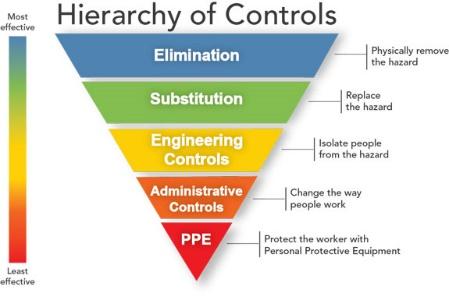
The COVID-19 Pandemic has put the discussion of the uses and effectiveness of face coverings center stage. People that have never been required to wear face coverings, masks, or N-95s are now donning these devices with varying expectations regarding protection for themselves and others. However, face coverings and respirators are not new. Over 110 years ago, the U.S. Department of the Interior established a new department called the United States Bureau of Mines (USBM) with the task of addressing the high fatality rate of mine workers. In 1919, the USBM launched the first respirator certification program in the U.S. Since this initial adoption, respirators have continued to protect the health and safety of professionals working with or near certain hazardous materials.
Surprisingly, even with such a rich history of respirator use for protecting the health and safety of workers, there remain many challenges with using them properly.
Current Day Use of Respirators
 When faced with the task of reducing or eliminating exposure to hazards, the Hierarchy of Controls is an essential tool. It is a list that shows the most effective controls to the least effective controls, stating that engineering controls are used first, then administrative controls, and finally personal protective equipment controls. When engineering and administrative controls are not an option, workers exposed to hazards use PPE to provide the best level of protection the situation allows.
When faced with the task of reducing or eliminating exposure to hazards, the Hierarchy of Controls is an essential tool. It is a list that shows the most effective controls to the least effective controls, stating that engineering controls are used first, then administrative controls, and finally personal protective equipment controls. When engineering and administrative controls are not an option, workers exposed to hazards use PPE to provide the best level of protection the situation allows.
When working in environments that have hazardous chemicals (e.g., painters and welders), one of the most common types of PPE is the respirator. Respirators can be very beneficial if used correctly, but if used improperly, the risks far outweigh the benefits.
5 Challenges and Solutions for Respirator Use
Improper Respirator use can easily be remedied. Below are five common mistakes when using respirators with corresponding solutions for fixing these common mistakes:
- Using the Wrong Type of Respirator
Respirators come in a multitude of types: filtering-face piece, full-face, half-face, supplied air respirators, and self-contained breathing apparatuses. Using the right type can make a large difference in reducing your exposure to the hazard. For example, a filtering face-piece respirator does not provide protection against gases and vapors while half-face respirators only cover the nose and mouth, requiring additional protection for the eyes. Supplied air respirators are best for oxygen deficient atmospheres or environments where the contaminant level is very high. A filtering-face piece respirator would only be adequate in dusty environments and a half-face or full-face respirator would work in environments that have vapors or fumes. Using the right respirator for the right hazards ensures that you are adequately protected and significantly reduces risk of exposure. Be sure to conduct a hazard risk assessment of your environment and research which respirators are required to be effective at reducing the exposure of the identified hazards. - Using the Wrong Cartridges
Cartridges are the part of respirators that reduce hazard exposure by filtering the air going into the respirator. However, respirator cartridges are designed to work with specific chemicals and utilizing the wrong cartridges can lead to adverse consequences. Some cartridges are designed for acidic environments, some for dusty environments, and still others strictly for gases or vapors. It is important to choose the right cartridge for the right job. A respirator cartridge selection guide can help you with this. 3M has a good selection guide we suggest using. - Not Changing the Filters
You have the right filter but what happens if it becomes saturated? Filters do not have an infinite lifespan and need to be changed on a regular basis. Reasons for needing to change out an old filter may be due to oversaturation from the hazard, or if the filter has exceeded its lifecycle. To prevent accidentally using bad filters, create a changeout schedule for all filters in use and put someone in charge of maintaining the schedule and changing out old filters. The recommended lifespan or timeline to change out filters is often provided by the manufacturer. If not, plan on changing them out every six months. If you can ever taste or smell the contaminant, or if breathing becomes more difficult, while wearing the respirator, change the filters immediately. - Having Facial Hair
A half-face or full-face respirator is only as good as the seal it can form against your face. A respirator works by forming a seal around the face, preventing any contaminants from being inhaled through tiny cracks. However, when facial hair is present, the respirator cannot form a proper seal, allowing the outside hazard to enter your breathing zone. If that beard is just too hard to part with, switch to a hooded powered air purifying respirator or positive pressure self-contained breathing apparatus with an over the head hood to ensure adequate protection. - Not Getting Fit-tested
As we mentioned with the fourth challenge, a respirator must form a proper seal against the wearer’s face to do its job effectively. A major contributing factor to a good seal is choosing the correct size of respirator and ensuring it fits properly. If a respirator does not fit correctly, it won’t create an effective seal and the wearer may not get the required protection. The best way to fix this problem is to ensure that you are properly fit-tested by a qualified respirator fit-tester.

Need Help?
Are you having trouble developing or implementing a respiratory protection plan for your business? ASG can help! We have extensive experience in building EHS capabilities for our clients, having completed over 15,000 EHS audits and conducted over 3,000 workplace risk assessments in 16 years of business. Additionally, ASG provides fit testing services to ensure that you receive the protection you need while working with or near hazardous materials.
Email: instructor@asg-inc.org
Phone: 757-223-7233

